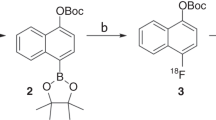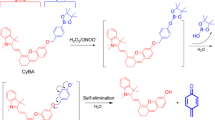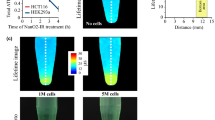Abstract
Nitric oxide (NO), a simple diatomic free radical, is known to play a critical physiological role in diverse organisms. An iron complex, with N-(dithiocarboxy)sarcosine (Fe-DTCS), has a high affinity for endogenous NO and can trap, stabilize, and accumulate it. The stable NO adduct thus formed is detectable at room temperature with electron paramagnetic resonance (EPR) spectrometry. We report in vivo EPR imaging of endogenous NO, trapped by an Fe-DTCS complex, in the abdomen of a live mouse. To our knowledge, this is the first report on EPR imaging of endogenous free radicals produced in vivo. This EPR imaging method will be useful for the noninvasive investigation of the spatial distribution of NO in pathologic organs or tissues.
This is a preview of subscription content, access via your institution
Access options
Subscribe to this journal
Receive 12 print issues and online access
$209.00 per year
only $17.42 per issue
Buy this article
- Purchase on Springer Link
- Instant access to full article PDF
Prices may be subject to local taxes which are calculated during checkout
Similar content being viewed by others
References
Moncada, S., Palmer, R.M.J., and Higgs, E.A. 1991. Nitric oxide: physiology, patho-physiology, and pharmacology. Pharmacol. Rev. 43: 109–142.
Feldman, P.L., Griffith, O.W., and Stuehr, D.J. 1993. The surprising life of nitric oxide. Chem. Eng. News 71: 26–38.
Chen, Y. and Rosazza, J.P.N. 1994. A bacterial nitric oxide synthase from a Nocardia species. Biochem. Biophys. Res. Commun. 203: 1251–1258.
Noguchi, T., Honda, J., Nagamune, T., Sasabe, H., Inoue, Y., et al. 1995. Photosensitive nitrite hydratase intrinsically possesses nitric oxide bound to the non-heme iron center evidence by Fourier transform infrared spectroscopy. FEBS Lett 358: 9–12.
Palmer, R.M.J., Ferrige, A.G., and Moncada, S. 1987. Nitric oxide release accounts for the biological activity of endothelium-derived relaxing factor. Nature 327: 524–526.
Archer, S. 1993. Measurement of nitric oxide in biological models. FASEB J. 7: 349–360.
Berliner, L.J. and Fujii, H. 1992. Some applications of ESR to in vivo animal studies and EPR imaging, pp. 307–319 in Biological magnetic resonance, vol 11, Berliner, L.J. and Reuben, J. (eds.). Plenum Press, New York.
Colacicchi, S., Alecci, M., Gualtieri, G., Quaresima, V., Ursini, C.L., et al. 1993. New experimental procedures for in vivo L-band frequency EPR spectroscopy/ imaging. J. Chem. Soc. Perkin Trans. 2077–2082.
Ishida, S., Matsumoto, S., Yokoyama, H., Mori, N., Kumashiro, H., et al. 1992. An ESR-CT imaging of the head of a living rat receiving an administration of a nitroxide radical. Magn. Reson. Imag. 10: 109–114.
Janzen, E.G. 1971. Spin trapping. Acc. Chem. Res. 4: 31–40.
Buettner, G.B. 1987. Spin trapping: ESR parameters of spin adducts. Free Rad. Biol. Med. 3: 259–303.
Mordvintcev, P., Mülsch, A., Busse, R., and Vanin, A. 1991. On-line detection of nitric oxide formation in liquid aqueous phase by electron paramagnetic resonance spectroscopy. Anal. Biochem. 199: 142–146.
Kalyanaraman, J.B. and Hyde, J.S. 1993. Trapping of nitric oxide by nitronyl nitroxide: an electron spin resonance investigation. Biochem. Biophys. Res. Commun. 192: 926–934.
Korth, H-G., Sustmann, R., Lommes, P., Paul, T., Ernst, A., et al. 1994. Nitric oxide cheletropic traps (NOCTs) with improved thermal stability and water solubility. J. Am. Chem. Soc. 116: 2767–2777.
Lai, C-S. and Komarov, A.M. 1994. Spin trapping of nitric oxide produced in vivo in septic-shock mice. FEBS Lett. 345: 120–124.
Yoshimura, T., Fujii, S., Yokoyama, H., and Kamada, H. 1995. In vivo electron paramagnetic resonance imaging of NO-bound iron complex in a rat head. Chem. Lett. 309–310.
Sakai, Y. 1980. hotometric determination of copper with N-(dithiocarboxy)sarcosine after preconcentration with amberiite XAD-2 resin. Talanta 27: 1073–1076.
Stuehr, D.J. and Marietta, M.A. 1985. Mammalian nitrate biosynthesis: mouse macrophages produce nitrite and nitrate in response to Escherichia coli lipopolysac-charide. Proc. Natl Acad. Sci. USA 82: 7738–7742.
Westenberger, U., Thanner, S., Ruf, H.H., Gersonde, K., Sutter, G., et al. 1990. Formation of free radicals and nitric oxide derivative of hemoglobin in rats during shock syndrome. Free Rad. Res. Comms. 11: 167–178.
Paratt, J.R. 1973. Myocardial and circulatory effects of E coli endotoxin; modification of responses to catecholamines. Br. J. Pharmacol. 47: 12–25.
Suffredini, A.F., Fromm, R.E., Parker, M.M., Brenner, M., Kovacs, J.A., et al. 1989. The cardiovascular response of normal humans to the administration of endotoxin. N. Engl. J. Med. 321: 280–287.
Kubrina, L.N., Mikoyan, V.D., Mordvintcev, P.I., and Vanin, A.F. 1993. Iron potentiates bacterial lipopolysaccharide-induced nitric oxide formation in animal organ. Biochim. Biophys. Acta 1176: 140–144.
Shinobu, L.A., Jones, S.G., and Jones, M.M. 1984. Sodium N-methyl-D-glucamine dithiocarbamate and cadmium intoxication. Acta Pharmacol. Toxicol. 54: 189–194.
Oikawa, K., Ogata, T., Togashi, H., Lin, Y., Sato, T., et al. 1995. Rapid field scan L-band electron spin resonance computed tomography system using an air-core electromagnet. Anal. Sci. 11: 885–889.
Yokoyama, H., Ogata, T., Tsuchihashi, N., Hiramatsu, M., and Mori, N. 1996. A spattotem-poral study on the distribution of intraperitoneally injected nitroxide radical in the rat head using an in vivo ESR imaging system. Magnetic Resonance Imaging 14:In press.
Lauterbur, P.C. 1973. Image formation by induced local interactions: examples employing nuclear magnetic resonance. Nature 242: 190–191.
Jansson, P.A. 1984. Deconvolution with application in spectroscopy. Academic Press, New York.
Author information
Authors and Affiliations
Rights and permissions
About this article
Cite this article
Yoshimura, T., Yokoyama, H., Fujii, S. et al. In vivo EPR detection and imaging of endogenous nitric oxide in lipopolysaccharide-treated mice. Nat Biotechnol 14, 992–994 (1996). https://doi.org/10.1038/nbt0896-992
Received:
Accepted:
Issue Date:
DOI: https://doi.org/10.1038/nbt0896-992
This article is cited by
-
Functional dissection of neural circuitry using a genetic reporter for fMRI
Nature Neuroscience (2022)
-
RF/Microwave Resonators for Preclinical and Clinical EPR Applications: Current Status and Challenges
Applied Magnetic Resonance (2022)
-
Three-dimensional electron spin resonance imaging of endogenous nitric oxide radicals generated in living plants
Biophysics Reports (2018)
-
Regulation of nitric oxide signaling by formation of a distal receptor–ligand complex
Nature Chemical Biology (2017)
-
Reaching the quantum limit of sensitivity in electron spin resonance
Nature Nanotechnology (2016)



